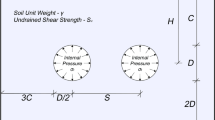Abstract
The stability of soil overlying the cavity is often a concern when it comes to the risk of sinkhole occurrences. Current sinkhole studies have been centred on the use of geophysical techniques to detect underground cavity sizes and associated depths. With the measured information, it is possible to theoretically predict the extent of a ground surface collapse. This paper studies the stability of trapdoors and the associated extent of ground surface failure. The shear strength reduction method is used to obtain factors of safety for various scenarios associated with the collapse of a three-dimensional trapdoor underlying undrained clay. Numerical solutions are verified by using the finite element limit analysis technique with upper and lower bound theorems and other published results. A number of practical examples are provided to demonstrate the use of design charts and tables, which can be used together with the application of geophysical tools to predict sinkhole occurrences.











Similar content being viewed by others
References
Broms BB, Bennermark H (1967) Stability of clay at vertical openings. J Soil Mech Found Div 93(1):71–94
Mair, RJ 1979, 'Centrifuge modelling of tunnel construction in soft clay', PhD Thesis, University of Cambridge.
Craig W (1990) Collapse of cohesive overburden following removal of support. Can Geotech J 27(3):355–364
Abdulla WA, Goodings DJ (1996) Modeling of sinkholes in weakly cemented sand. J Geotechn Eng 122(12):998–1005
Jacobsz, S 2016, 'Trapdoor experiments studying cavity propagation', in Proceedings of the 1st Southern African Geotechnical Conference, Durban, South Africa, 18–19 October 2016, CRC Press, pp. 159–65.
Sloan S, Assadi A, Purushothaman N (1990) Undrained stability of a trapdoor. Geotechnique 40(1):45–62
Yang MZ, Drumm EC (2002) Stability evaluation for the siting of municipal landfills in karst. Eng Geol 65(2):185–195
Augarde CE, Lyamin AV, Sloan SW (2003) Prediction of undrained sinkhole collapse. J Geotechn Geoenviron Eng 129(3):197–205
Drumm EC, Aktürk Ö, Akgün H, Tutluoğlu L (2009) Stability charts for the collapse of residual soil in karst. J Geotechn Geoenviron Eng 135(7):925–931
Keawsawasvong S, Ukritchon B (2017) Undrained stability of an active planar trapdoor in non-homogeneous clays with a linear increase of strength with depth. Comput Geotech 81:284–293
Keawsawasvong, S. and Ukritchon, B. 2021, “Undrained stability of plane strain active trapdoors in anisotropic and non-homogeneous clays”, Tunnelling and Underground Space Technology, 107, 103628.
Keawsawasvong S (2021) Limit analysis solutions for spherical cavities in sandy soils under overloading. Innov Infrastruct Solut 6:33
Keawsawasvong S, Ukritchon B (2019) Undrained stability of a spherical cavity in cohesive soils using finite element limit analysis. J Rock Mech Geotechn Eng 11(6):1274–1285
Shiau J, Hassan MM (2019) Undrained stability of active and passive trapdoors. Geotechn Res 7:1. https://doi.org/10.1680/jgere.19.00033
Shiau, J, Pather, S & Ayers, R 2006 “Developing physical models for geotechnical teaching and research’, Proc. 6th IC Physical Modelling in Geotechnics, 157–162.
Shiau, J & Al-Asadi, F 2020, 'Determination of critical tunnel heading pressures using stability factors', Computers and Geotechnics, vol. 119, p. 103345.
Shiau J, Sams M, Lamb B (2016) Introducing advanced topics in geotechnical engineering teaching–Tunnel modelling. Int J of GEOMATE 10(1):1698–1705
Shiau J, Lamb B, Sams M (2016) The use of sinkhole models in advanced geotechnical engineering teaching. Int J GEOMATE 10(2):1718–1724
Vardoulakis I, Graf B, Gudehus G (1981) Trap-door problem with dry sand: A statical approach based upon model test kinematics. Int J Numer Anal Meth Geomech 5(1):57–78
Leca E, Dormieux L (1990) Upper and lower bound solutions for the face stability of shallow circular tunnels in frictional material. Geotechnique 40(4):581–606
Mollon G, Dias D, Soubra A-H (2009) Face stability analysis of circular tunnels driven by a pressurized shield. J Geotechn Geoenviron Eng 136(1):215–229
Subrin D, Wong H (2002) Tunnel face stability in frictional material: a new 3D failure mechanism. CR Mec 330(7):513–519
Ibrahim E, Soubra A-H, Mollon G, Raphael W, Dias D, Reda A (2015) Three-dimensional face stability analysis of pressurized tunnels driven in a multilayered purely frictional medium. Tunn Undergr Space Technol 49:18–34
Fraldi M, Guarracino F (2009) Limit analysis of collapse mechanisms in cavities and tunnels according to the Hoek-Brown failure criterion. Int J Rock Mech Min Sci 46(4):665–673
Yang X, Huang F (2013) Three-dimensional failure mechanism of a rectangular cavity in a Hoek-Brown rock medium. Int J Rock Mech Min Sci 61:189–195
Shiau J, Al-Asadi F (2018) Revisiting Broms and Bennermarks’ original stability number for tunnel headings. Geotechn Lett 8(4):310–315
OptumG3, 2018, Optum Computational Engineering, https://optumce.com/
Terzaghi K (1936) Stress distribution in dry and saturated sand above a yielding trap-door. Proceedings of the International Conference of Soil Mechanic, Harvard university Press, Cambridge 1(4):307–311
Finn W (1963) Boundary values problems of soil mechanics. J Soil Mech Found Div 89(5):39–72
Author information
Authors and Affiliations
Contributions
All authors contributed to the study conception and design. Conceptualization: JS. Methodology: JS. Formal analysis and investigation: JS and MMH Writing—original draft preparation: JS and MMH. Writing—review and editing: JS and MMH. Resources: JS. Supervision: JS.
Corresponding author
Additional information
Publisher's Note
Springer Nature remains neutral with regard to jurisdictional claims in published maps and institutional affiliations.
Rights and permissions
About this article
Cite this article
Shiau, J., Hassan, M.M. Numerical Investigation of Undrained Trapdoors in Three Dimensions. Int. J. of Geosynth. and Ground Eng. 7, 30 (2021). https://doi.org/10.1007/s40891-021-00283-w
Received:
Accepted:
Published:
DOI: https://doi.org/10.1007/s40891-021-00283-w




